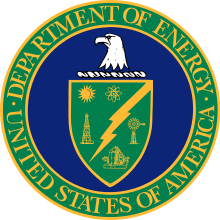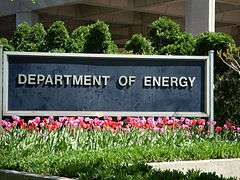United States Department of Energy
The United States Department of Energy (DOE) is a cabinet-level department of the United States Government concerned with the United States' policies regarding energy and safety in handling nuclear material. Its responsibilities include the nation's nuclear weapons program, nuclear reactor production for the United States Navy, energy conservation, energy-related research, radioactive waste disposal, and domestic energy production. It also directs research in genomics; the Human Genome Project originated in a DOE initiative.[3] DOE sponsors more research in the physical sciences than any other U.S. federal agency, the majority of which is conducted through its system of National Laboratories.[4] The agency is administered by the United States Secretary of Energy, and its headquarters are located in Southwest Washington, D.C., on Independence Avenue in the James V. Forrestal Building, named for James Forrestal, as well as in Germantown, Maryland.
 Seal of the U.S. Department of Energy | |
 Flag of the U.S. Department of Energy | |
 James V. Forrestal Building, Department Headquarters | |
| Agency overview | |
|---|---|
| Formed | August 4, 1977 |
| Preceding agencies | |
| Headquarters | James V. Forrestal Building 1000 Independence Avenue Southwest, Washington, D.C., U.S. 38°53′13″N 77°1′34″W |
| Employees | 14,382 federal civilian (2018)[1] 93,094 contract (2008) |
| Annual budget | $31.7 billion (2020)[2] |
| Agency executives | |
| Website | energy |
| Footnotes | |
Dan Brouillette is the Secretary of Energy as of December 11, 2019.[5]
History
Formation and consolidation
In 1942, during World War II, the United States started the Manhattan Project, a project to develop the atomic bomb, under the eye of the U.S. Army Corps of Engineers. After the war in 1946, the Atomic Energy Commission (AEC) was created to control the future of the project.[6][7] Among other nuclear projects, the AEC produced fabricated uranium fuel cores at locations such as Fernald Feed Materials Production Center in Cincinnati, Ohio.[8][9][10] In 1974, the AEC gave way to the Nuclear Regulatory Commission, which was tasked with regulating the nuclear power industry, and the Energy Research and Development Administration, which was tasked to manage the nuclear weapon, naval reactor, and energy development programs.
The 1973 oil crisis called attention to the need to consolidate energy policy.[11][12][13] On August 4, 1977, President Jimmy Carter signed into law The Department of Energy Organization Act of 1977 (Pub.L. 95–91, 91 Stat. 565, enacted August 4, 1977), which created the Department of Energy.[14] The new agency, which began operations on October 1, 1977, consolidated the Federal Energy Administration, the Energy Research and Development Administration, the Federal Power Commission, and programs of various other agencies. Former Secretary of Defense James Schlesinger, who served under Presidents Nixon and Ford during the Vietnam War, was appointed as the first secretary.
Weapon plans stolen
In December 1999, the FBI was investigating how China obtained plans for a specific nuclear device. Wen Ho Lee was accused of stealing nuclear secrets from Los Alamos National Laboratory for the People's Republic of China. Federal officials, including then-Energy Secretary Bill Richardson, publicly named Lee as a suspect before he was charged with a crime. The U.S. Congress held hearings to investigate the Department of Energy's mishandling of his case. Republican senators thought that an independent agency should be in charge of nuclear weapons and security issues, not the Department of Energy.[15] All but one of the 59 charges against Lee were eventually dropped because the investigation finally proved that the plans the Chinese obtained could not have come from Lee. Lee filed suit and won a $1.6 million settlement against the federal government and news agencies.[16]
Loan guarantee program of 2005
In 2001, American Solar Challenge was sponsored by the United States Department of Energy and the National Renewable Energy Laboratory.[17] After the 2005 race, the U.S. Department of Energy discontinued its sponsorship.[18]
Title XVII of Energy Policy Act of 2005 authorizes the DOE to issue loan guarantees to eligible projects that "avoid, reduce, or sequester air pollutants or anthropogenic emissions of greenhouse gases" and "employ new or significantly improved technologies as compared to technologies in service in the United States at the time the guarantee is issued".[19] In loan guarantees, a conditional commitment requires to meet an equity commitment, as well as other conditions, before the loan guarantee is completed.[20]
The United States Department of Energy, the Nuclear Threat Initiative (NTI), the Institute of Nuclear Materials Management (INMM), and the International Atomic Energy Agency (IAEA) partnered to develop and launch the World Institute for Nuclear Security (WINS) in September 2008. WINS is an international non-governmental organization designed to provide a forum to share best practices in strengthening the security and safety of nuclear and radioactive materials and facilities.[21]
Recent
On March 28, 2017, a supervisor in the Office of International Climate and Clean Energy asked staff to avoid the phrases "climate change," "emissions reduction," or "Paris Agreement" in written memos, briefings or other written communication. A DOE spokesperson denied that phrases had been banned.[22][23]
In a May 2019 press release concerning natural gas exports from a Texas facility, the DOE used the term 'freedom gas' to refer to natural gas. The phrase originated from a speech made by Secretary Rick Perry in Brussels earlier that month. Washington Governor Jay Inslee decried the term "a joke".[24][25][26]
Energy
| Program | |
|---|---|
| Secretary of Energy | Deputy Secretary of Energy *Associate Deputy Secretary of Energy |
| Assistant Secretary of Energy (Energy Efficiency and Renewable Energy) | |
| Assistant Secretary of Energy (Nuclear Energy) | |
| Assistant Secretary of Energy (Electricity Delivery and Energy Reliability) | |
| Assistant Secretary of Energy (International Affairs) | |
| Assistant Secretary of Energy (Congressional and Intergovernmental Affairs) | |
| Assistant Secretary of Energy (Cybersecurity, Energy Security and Emergency Response)[27] | |
| Office of the General Counsel | |
| Office of the Chief Financial Officer | |
| Advanced Research Projects Agency-Energy | |
| Energy Information Administration | |
| Bonneville Power Administration | |
| Southeastern Power Administration | |
| Southwestern Power Administration | |
| Western Area Power Administration | |
| Federal Energy Regulatory Commission | |
| Enterprise Assessments | |
| Energy Policy and System Analysis | |
| Intelligence and Counterintelligence | |
| Loan Programs Office | |
| Public Affairs | |
| Small and Disadvantaged Business Utilization | |
| Under Secretary of Energy for Science | Office of Science |
| Assistant Secretary of Energy (Fossil Energy) | |
| Indian Energy Policy and Programs | |
| Technology Transitions | |
| Under Secretary of Energy for Nuclear Security | National Nuclear Security Administration |
| Under Secretary of Energy | National Laboratory Operations Board |
| Associate Under Secretary of Energy (Environment, Health, Safety and Security) | |
| Office of Management | |
| Chief Human Capital Officer | |
| Chief Information Officer | |
| Economic Impact and Diversity | |
| Hearings and Appeals | |
| Assistant Secretary of Energy (Environmental Management) *Legacy Management | |
The department is under the control and supervision of a United States Secretary of Energy, a political appointee of the President of the United States. The Energy Secretary is assisted in managing the department by a United States Deputy Secretary of Energy, also appointed by the president, who assumes the duties of the secretary in his absence. The department also has three under secretaries, each appointed by the president, who oversee the major areas of the department's work. The president also appoints seven officials with the rank of Assistant Secretary of Energy who have line management responsibility for major organizational elements of the Department. The Energy Secretary assigns their functions and duties.
Symbolism in the seal
Excerpt from the Code of Federal Regulations, in Title 10: Energy:[28]
The official seal of the Department of energy "includes a green shield bisected by a gold-colored lightning bolt, on which is emblazoned a gold-colored symbolic sun, atom, oil derrick, windmill, and dynamo. It is crested by the white head of an eagle, atop a white rope. Both appear on a blue field surrounded by concentric circles in which the name of the agency, in gold, appears on a green background."
"The eagle represents the care in planning and the purposefulness of efforts required to respond to the Nation's increasing demands for energy. The sun, atom, oil derrick, windmill, and dynamo serve as representative technologies whose enhanced development can help meet these demands. The rope represents the cohesiveness in the development of the technologies and their link to our future capabilities. The lightning bolt represents the power of the natural forces from which energy is derived and the Nation's challenge in harnessing the forces."
"The color scheme is derived from nature, symbolizing both the source of energy and the support of man's existence. The blue field represents air and water, green represents mineral resources and the earth itself, and gold represents the creation of energy in the release of natural forces. By invoking this symbolism, the color scheme represents the Nation's commitment to meet its energy needs in a manner consistent with the preservation of the natural environment."
Facilities
The Department of Energy operates a system of national laboratories and technical facilities for research and development, as follows:
- Ames Laboratory
- Argonne National Laboratory
- Brookhaven National Laboratory
- Fermi National Accelerator Laboratory
- Idaho National Laboratory
- Lawrence Berkeley National Laboratory
- Lawrence Livermore National Laboratory
- Los Alamos National Laboratory
- National Energy Technology Laboratory
- National Renewable Energy Laboratory
- Oak Ridge National Laboratory
- Pacific Northwest National Laboratory
- Princeton Plasma Physics Laboratory
- Sandia National Laboratories
- Savannah River National Laboratory
- SLAC National Accelerator Laboratory
- Thomas Jefferson National Accelerator Facility
Other major DOE facilities include:
- Albany Research Center
- Bannister Federal Complex
- Bettis Atomic Power Laboratory – focuses on the design and development of nuclear power for the U.S. Navy
- Kansas City Plant
- Knolls Atomic Power Laboratory – operates for Naval Reactors Program Research under the DOE (not a National Laboratory)
- National Petroleum Technology Office
- Nevada Test Site
- New Brunswick Laboratory
- Office of Fossil Energy[29]
- Office of River Protection[30]
- Pantex
- Radiological and Environmental Sciences Laboratory
- Y-12 National Security Complex
- Yucca Mountain nuclear waste repository
Other:
- Pahute Mesa Airstrip – Nye County, Nevada, in supporting Nevada National Security Site
Nuclear weapons sites
The DOE/NNSA has federal responsibility for the design, testing and production of all nuclear weapons. NNSA in turn uses contractors to carry out its responsibilities at the following government owned sites:
- Design of the nuclear components of the weapon: Los Alamos National Laboratory and Lawrence Livermore National Laboratory
- Engineering of the weapon systems: Sandia National Laboratories
- Manufacturing of key components: Los Alamos National Laboratory, the Kansas City Plant, and Y-12 National Security Complex
- Testing: Nevada Test Site
- Final weapon and warhead assembling and dismantling: Pantex
Related legislation

- 1920 – Federal Power Act
- 1935 – Public Utility Holding Company Act of 1935
- 1946 – Atomic Energy Act PL 79-585 (created the Atomic Energy Commission) [Superseded by the Atomic Energy Act of 1954]
- 1954 – Atomic Energy Act of 1954, as Amended PL 83-703
- 1956 – Colorado River Storage Project PL 84-485
- 1957 – Atomic Energy Commission Acquisition of Property PL 85-162
- 1957 – Price-Anderson Nuclear Industries Indemnity Act PL 85-256
- 1968 – Natural Gas Pipeline Safety Act PL 90-481
- 1973 – Mineral Leasing Act Amendments (Trans-Alaska Oil Pipeline Authorization) PL 93-153
- 1974 – Energy Reorganization Act PL 93-438 (Split the AEC into the Energy Research and Development Administration and the Nuclear Regulatory Commission)
- 1975 – Energy Policy and Conservation Act PL 94-163
- 1977 – Department of Energy Organization Act PL 95-91 (Dismantled ERDA and replaced it with the Department of Energy)
- 1978 – National Energy Act PL 95-617, 618, 619, 620, 621
- 1980 – Energy Security Act PL 96-294
- 1989 – Natural Gas Wellhead Decontrol Act PL 101-60
- 1992 – Energy Policy Act of 1992 PL 102-486
- 2000 – National Nuclear Security Administration Act PL 106-65
- 2005 – Energy Policy Act of 2005 PL 109-58
- 2007 – Energy Independence and Security Act of 2007 PL 110-140
- 2008 – Food, Conservation, and Energy Act of 2008 PL 110-234
Budget
President Barack Obama unveiled on May 7, 2009, a $26.4 billion budget request for DOE for fiscal year (FY) 2010, including $2.3 billion for the DOE Office of Energy Efficiency and Renewable Energy (EERE). The budget aims to substantially expand the use of renewable energy sources while improving energy transmission infrastructure. It also makes significant investments in hybrids and plug-in hybrids, in smart grid technologies, and in scientific research and innovation.[31]
As part of the $789 billion economic stimulus package in the American Recovery and Reinvestment Act of 2009, Congress provided Energy with an additional $38.3 billion for fiscal years 2009 and 2010, adding about 75 percent to Energy's annual budgets. Most of the stimulus spending was in the form of grants and contracts. For fiscal year 2013, each of the operating units of the Department of Energy operated with the following budgets:[32]
| Division | Funding |
|---|---|
| Nuclear Security | $11.5 |
| Energy and Environment | $9.5 |
| Science | $4.9 |
| Management | $0.25 |
| Other | $0.85 |
| Total | $28 |
In March 2018, Energy Secretary Rick Perry testified to a Senate panel about the Trump administration's DOE budget request for fiscal year 2019. The budget request prioritizes nuclear security while making large cuts to energy efficiency and renewable energy programs. The proposal is a $500 million increase in funds over fiscal year 2017. It "promotes innovations like a new Office of Cybersecurity, Energy Security, and Emergency Response (CESER) and gains for the Office of Fossil Energy. Investments would be made to strengthen the National Nuclear Security Administration and modernize the nuclear force, as well as in weapons activities and advanced computing." However, the budget for the Office of Energy Efficiency and Renewable Energy would be lowered to $696 million under the plan, down from $1.3 billion in fiscal year 2017. Overall, the department's energy and related programs would be cut by $1.9 billion.[33]
Programs and contracts
Energy Savings Performance Contract
Energy Savings Performance Contracts (ESPCs) are contracts under which a contractor designs, constructs, and obtains the necessary financing for an energy savings project, and the federal agency makes payments over time to the contractor from the savings in the agency's utility bills. The contractor guarantees the energy improvements will generate savings, and after the contract ends, all continuing cost savings accrue to the federal agency.[34]
Energy Innovation Hubs
Energy Innovation Hubs are multi-disciplinary meant to advance highly promising areas of energy science and technology from their early stages of research to the point that the risk level will be low enough for industry to commercialize the technologies.[31] The Consortium for Advanced Simulation of Light Water Reactors (CASL) was the first DOE Energy Innovation Hub established in July 2010, for the purpose of providing advanced modeling and simulation (M&S) solutions for commercial nuclear reactors.[35]
The 2009 DOE budget includes $280 million to fund eight Energy Innovation Hubs, each of which is focused on a particular energy challenge. Two of the eight hubs are included in the EERE budget and will focus on integrating smart materials, designs, and systems into buildings to better conserve energy and on designing and discovering new concepts and materials needed to convert solar energy into electricity. Another two hubs, included in the DOE Office of Science budget, were created to tackle the challenges of devising advanced methods of energy storage and creating fuels directly from sunlight without the use of plants or microbes. Yet another hub was made to develop "smart" materials to allow the electrical grid to adapt and respond to changing conditions.[31]
In 2012, The DOE awarded $120 million to the Ames Laboratory to start a new EIH, the Critical Materials Institute, which will focus on improving the supply of rare earth elements, which is controlled by China.[36]
Advanced Research Projects Agency-Energy
ARPA-E was officially created by the America COMPETES Act , authored by Congressman Bart Gordon,[37] within the United States Department of Energy (DOE) in 2007, though without a budget. The initial budget of about $400 million was a part of the economic stimulus bill of February 2009.[38]
Other
- State Energy Program
- Weatherization Assistance Program
- Federal Energy Management Program
- GovEnergy - an annual event partly sponsored by the DOE
- Solar Decathlon - international collegiate competition to design and build solar-powered houses
- National Science Bowl - a high school and middle school science knowledge competition
List of Secretaries of Energy
| # | Name | Term | President served | |
|---|---|---|---|---|
| Start | End | |||
| 1 | James R. Schlesinger | August 6, 1977 | August 23, 1979 | Jimmy Carter |
| 2 | Charles W. Duncan, Jr. | August 24, 1979 | January 20, 1981 | |
| 3 | James B. Edwards | January 23, 1981 | November 5, 1982 | Ronald Reagan |
| 4 | Donald Paul Hodel | November 5, 1982 | February 7, 1985 | |
| 5 | John S. Herrington | February 7, 1985 | January 20, 1989 | |
| 6 | James D. Watkins | March 1, 1989 | January 20, 1993 | George H. W. Bush |
| 7 | Hazel R. O'Leary | January 22, 1993 | January 20, 1997 | Bill Clinton |
| 8 | Federico F. Peña | March 12, 1997 | June 30, 1998 | |
| 9 | Bill Richardson | August 18, 1998 | January 20, 2001 | |
| 10 | Spencer Abraham | January 20, 2001 | January 31, 2005 | George W. Bush |
| 11 | Samuel W. Bodman | February 1, 2005 | January 20, 2009 | |
| 12 | Steven Chu | January 21, 2009 | April 22, 2013 | Barack Obama |
| 13 | Ernest Moniz | May 16, 2013 | January 20, 2017 | |
| 14 | Rick Perry | March 2, 2017 | December 1, 2019 | Donald Trump |
| 15 | Dan Brouillette | December 4, 2019 | Present | |
See also
- United States federal executive departments
- Federal Energy Regulatory Commission
- National Council on Electricity Policy
Notes
References
- "Department of Energy". FedScope Federal Workforce Data. United States Office of Personnel Management. Retrieved October 17, 2019.
- "The Budget for Fiscal Year 2020". Archived from the original on March 11, 2019. Retrieved April 21, 2020.
- "Genomes to Life, Black Bag" (PDF). U.S. Department of Energy. Spring 2002.
- "NSF Science and Engineering Indicators 2012". National Science Foundation. Archived from the original on July 6, 2017.
- President Donald J. Trump Presides Over Swearing-In Of Dan Brouillette As 15th Secretary Of Energy
- "Manhattan Project Background Information and Preservation Work". Department of Energy. Retrieved July 11, 2016.
- Gosling, F. G. (January 2010). "The Manhattan Project: Making the Atomic Bomb" (PDF). Department of Energy. Retrieved July 11, 2016.
- National Lead Company of Ohio, Contract Operator of the Feed Materials Production Center for the U.S. Atomic Energy Commission. The Feed Materials Production Center. NCLO-950. n. d.
- "Fernald Closure Project: The End of Secrecy". Department of Energy, Office of Legacy Management. Retrieved December 27, 2016.
- "History of the Fernand Site". U.S. Department of Energy, Office of Legacy Management. Retrieved December 27, 2016.
- "Environment: The Energy Crisis: Time for Action". TIME. May 7, 1973.
- Smith, William D. (April 17, 1973). "Energy Crisis: Shortages Amid Plenty". The New York Times. New York. Retrieved September 5, 2016.
- Welles, Chris (February 25, 1973). "The Energy Crisis". The New York Times. New York. Retrieved September 5, 2016.
- Relyea, Harold; Carr, Thomas P. (2003). The Executive Branch, Creation and Reorganization. Nova Publishers. p. 29.
- Plotz, David (June 23, 2000). "Energy Secretary Bill Richardson. He schmoozes. He loses". Slate.com. Retrieved November 7, 2008.
- Mears, Bill (May 22, 2006). "Deal in Wen Ho Lee case may be imminent". CNN. Archived from the original on February 7, 2007. Retrieved November 7, 2008.
- "State Energy Advisory Board resolution" (PDF). US Department of Energy. Retrieved May 26, 2017.
- "Toyota Sponsors World's Longest Solar Car Race". Toyota. July 30, 2008. Archived from the original on September 27, 2011.
- "Loan Guarantee Program". Department of Energy. December 31, 2006. Archived from the original on February 1, 2010. Retrieved August 25, 2009.
- "DOE Offers $535 Million Loan Guarantee to Solyndra, Inc". Office of Energy Efficiency and Renewable Energy. March 20, 2009. Retrieved August 25, 2009.
- "Institute To Strengthen Security for Nuclear Materials". Security Today. September 30, 2008.
- Wolff, Eric (March 29, 2017). "Energy Department climate office bans use of phrase 'climate change'". Politico. Retrieved March 30, 2017.
- Dwibhashyam, Pavitra (March 30, 2017). "US Energy Department tells staff not to use words like climate change and Paris agreement". International Business Times. Retrieved March 30, 2017.
- Bowden, John (May 29, 2019). "Trump energy officials label natural gas 'freedom gas'". The Hill. Retrieved May 29, 2019.
- Wu, Nicholas (May 29, 2019). "Department of Energy refers to 'freedom gas' and 'molecules of U.S. freedom' in press release". USA Today. Retrieved May 29, 2019.
- Weissmann, Jordan (May 29, 2019). "The Department of Energy Is Now Calling Fossil Fuels "Molecules of Freedom" and "Freedom Gas"". Slate. Retrieved May 29, 2019.
- "Secretary of Energy Rick Perry Forms New Office of Cybersecurity, Energy Security, and Emergency Response". Department of Energy. February 14, 2018. Retrieved June 16, 2018.
- "Code of Federal Regulations, Title 10 - Energy, Part 1002 - Official Seal and Distinguishing Flag". U.S. Government Publishing Office.
- "Office of Fossil Energy". Department of Energy. Retrieved January 22, 2017.
- "Office of River Protection". Archived from the original on January 4, 2010. Retrieved January 18, 2010.
- "DOE Requests $2.3 Billion for Efficiency, Renewable Energy in FY 2010". EERE News. May 13, 2009. Retrieved August 25, 2009.
- "Department of Energy: FY 2014 Congressional Budget Request" (PDF). Department of Energy – Office of the Chief Financial Officer. April 2013.
- Galford, Chris (March 20, 2018). "Perry defends nuclear investment and cuts to renewables in $30.6 bln DOE budget proposal". Daily Energy Insider. Retrieved March 22, 2018.
- "DOE Awards 16 Contracts for Energy Savings at Federal Facilities". EERE News. January 7, 2009. Retrieved August 25, 2009.
- Kulesza, Joel; Franceschini, Fausto; Evans, Thomas; Gehin, Jess (February 3, 2016). "Overview of the Consortium for the Advanced Simulation of Light Water Reactors (CASL)". EPJ Web of Conferences. 106: 03002. doi:10.1051/epjconf/201610603002.
- Cooney, Michael (January 9, 2013). "US spots $120M for lab to tackle rare earth shortages". Network World. Retrieved January 16, 2013.
- Gordon, Bart (May 19, 2010). "H.R.5325 - 111th Congress (2009-2010): America COMPETES Reauthorization Act of 2010". United States Congress.
- Leopold, George (February 23, 2009). "Stimulus: Energy Department scrambles to build new R&D agency". EE Times. Retrieved August 14, 2011.
Further reading
- Cumming, Alfred (February 9, 2009). "Polygraph Use by the Department of Energy: Issues for Congress" (PDF). Congressional Research Service. Archived from the original (PDF) on March 28, 2014 – via Federation of American Scientists.
External links
| Wikimedia Commons has media related to United States Department of Energy. |